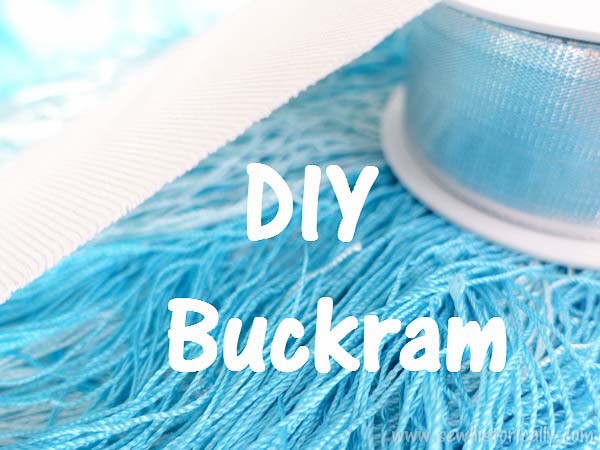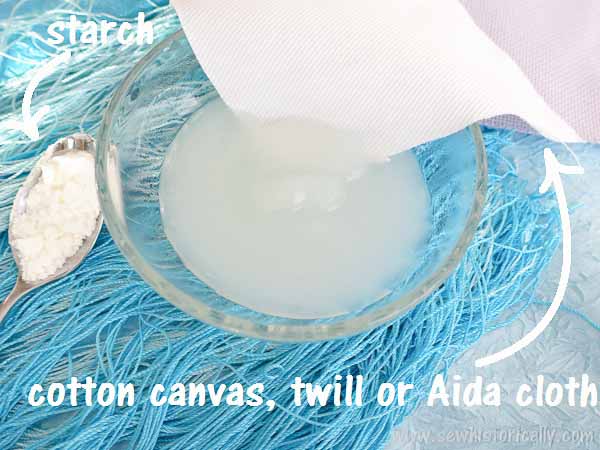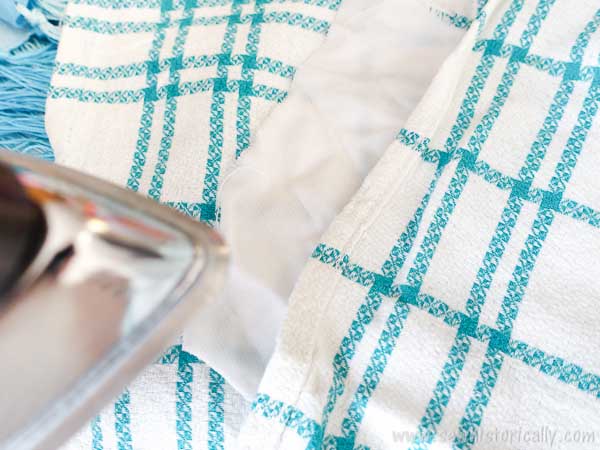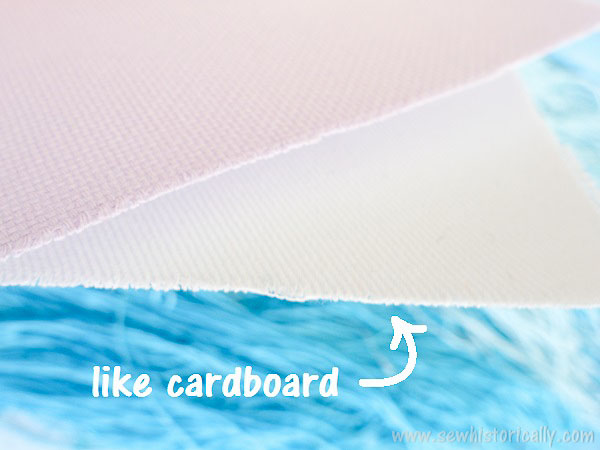Buckram is a very stiff fabric, almost like cardboard. Buckram is used for millinery and historical clothing. You can buy buckram but buckram is easy to make at home: All you need is cornstarch and cotton or linen fabric – I usually use cotton canvas, twill or Aida cloth.
>>> PIN IT <<<
You’ll need:
- 4 tbsp starch – I used cornstarch
- 1 cup water
- cotton canvas, twill or Aida cloth
Whisk the cornstarch into the water (make sure there are no lumps). Stirring continously, cook it until the milky white solution turns clear.
As soon as it’s cool enough, dip the fabric into the starch. Squeeze out excess starch. Here I’m starching just a small piece of fabric that I needed for my 1920s flower but you can also starch a larger piece of fabric.
Place the starched fabric between a kitchen towel and iron it dry.
Uses For DIY Buckram
You can use DIY buckram for Victorian bonnet forms, 1920s cloche hats, detachable starched Edwardian collars, DIY lampshades and as foundation for beaded Indian tassels.
I used DIY buckram for my 1840s bonnet form. This DIY bonnet form is as stiff as cardboard but it’s more flexible than cardboard. I also used DIY buckram as foundation for the 1920s flower dress accessory.





So interesting, I love seeing all the amazing historical outfits you make so it’s interesting to see a little more behind the scenes too.
Thanks, Julie! 😀
That is fantastic! I think it’s wonderful that you can make buckram for yourself. I know that it can be very costly making the beautiful things that you do, and this is a great, frugal idea. Thank you so much for sharing this post with the Hearth and Soul Link Party, Lina. I really appreciate your support. Hope you are having a lovely weekend!
Thanks so much, April! 🙂
Has this been tried for rebinding books? I’ll go ahead and try it, but am wondering if anyone else has tried it and to what effect.
Sorry I haven’t used it for rebinding books so I don’t know if it works. If you try it, please let me know if it works! 🙂
I have not bound books myself but aren’t insects a problem? I would be afraid that the starch would make the books more attractive unless I checked with a professional.
Hi there I have been trying this method but I’m curious about the measurement 4 tablespoon of starch to 1 cup water just gets super thick when cooked am I cooking too long I’m doing it in a pot is that OK it’s not becoming clear I must be doing something wrong please help
Hi, yes, the starch solution gets super thick! 😉 However, if it gets too thick, you can add more water. Have you used level tablespoons? And I’m cooking it in a pot too. Hope this helps! 🙂
Can I use ordinary cotton
Yes, you can also use sturdy cotton fabric.
Does buckram remain stiff with washing? Some of our sunbonnets are loaned to new volunteers, and staff bonnets are worn daily for the purposes the bonnets were intended (gardening, tending livestock, etc.), so they do need washed occasionally.
Thank you!
No, it doesn’t remain stiff, you have to starch it again after washing. But you can stiffen the sunbonnets with cording or removable cardboard slats instead. Both were used in the Victorian era to stiffen sunbonnets.
You are a lifesaver! Buckram is sooo expensive in Europe, I had almost given up the idea of making myself a hat. I will use your tip and make a removable stiffener so I can wash it. Thank you so much!
Thank you! It’s July 2021 and you can’t find much buckram, it’s not being made in the US any more. It’s pretty pricey for narrow stuff so I’ll be making my own… Which is cool, another layer of handmade. ?
Thank you! Glad you like it! 😀
Sorry if I’m just not seeing it but, what temp are you supposed to cook the mixture at? I’m pretty new to working with heat sources
Cook it over medium heat. 🙂
Hello, thanks for this tutorial! I tried this today and I think 4 tbsp was too much. It came out very thick, did not become clear, and solidified in the cooling process. I tried again using 4 teaspoons (instead of tablespoons) of corn starch and it came out just as pictured and I was able to prepare my fabric. 🙂 I think perhaps you meant teaspoons instead of tablespoons?
Thank you! Did you use level or heaping tablespoons? In the recipe, I used level tablespoons. And yes, the homemade starch is very thick and will solidify as it cools. 😉
hi, the issue regarding tablespoons could be down to imperial versus metric measurements. An American tablespoon is 15ml, or 3 teaspoons, whereas a metric tablespoon is 20ml. By the time you have 4 tablespoons in metric, 80ml, it’s a full metric tablespoon over the American 60ml requirement. As an aside, metric and imperial are different in cup volume too.
I hope this helps.
just FIY: you mention the DIY lampshade, but the link goes to gifts. I can’t find that tutorial via search bar.
The 1900s newspaper article is gone but here are two tutorials from the Edwardian era on how to make lamp-shades and candle-shades. 🙂